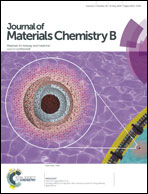Immobilization of urease on magnetic nanoparticles coated by polysiloxane layers bearing thiol- or thiol- and alkyl-functions
Abstract
Magnetically retrievable formulations of urease potentially promising for biomedical and environmental applications were constructed by immobilization of the enzyme on the surface of magnetite nanoparticles functionalized by siloxane layers with active thiol or thiol-and-alkyl moieties. The latter were deposited using a hydrolytic polycondensation reaction of tetraethoxysilane with either 3-mercaptopropyltrimethoxysilane, or with 3-mercaptopropyltrimethoxysilane and methyltriethoxysilane, or alternatively n-propyltriethoxysilane. Immobilization of urease was carried out in different ways for comparison: by adsorption, by entrapment during the hydrolytic polycondensation reaction, or by covalent bonding. For entrapment the enzyme was introduced into solution before functionalization of the magnetite. Entrapment bound high amounts of enzyme (more than 700 mg per g of carrier), but its activity was decreased compared to the native form to between 18 and 10%. In the case of covalent binding of urease using Ellman's Reagent, binding of the enzyme was almost as efficient as in the case of entrapment but its residual activity was 75%. The residual activity of urease immobilized by adsorption on the surface of thiol-functionalized particles was truly high as compared to that of the native enzyme (97%), but binding was significantly less efficient (46%). Introduction of alkyl functions permitted increase of the amounts of the adsorbed enzyme but its activity was somewhat decreased.


 Please wait while we load your content...
Please wait while we load your content...